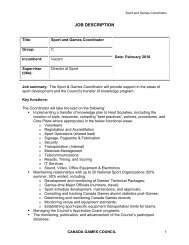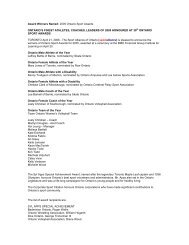Targets for Athlete Performance and the Sport System
Targets for Athlete Performance and the Sport System
Targets for Athlete Performance and the Sport System
Create successful ePaper yourself
Turn your PDF publications into a flip-book with our unique Google optimized e-Paper software.
International Trends in <strong>Sport</strong> <strong>System</strong> Development<br />
Globalization has been described as an increase in <strong>the</strong> free flow of in<strong>for</strong>mation, goods,<br />
capital, <strong>and</strong> people across borders that have been precipitated by <strong>the</strong> liberalization of trade <strong>and</strong><br />
advances in technology, telecommunications <strong>and</strong> finance. The result has been a more competitive<br />
global market place <strong>and</strong> a situation in which nations are <strong>for</strong>ced to compete <strong>for</strong> <strong>for</strong>eign investment<br />
needed to increase capital stock, support growth, <strong>and</strong> raise living st<strong>and</strong>ards. To attract <strong>for</strong>eign<br />
investment, nations must put on what has been described as <strong>the</strong> one size fits all (or made in <strong>the</strong><br />
USA) “golden straightjacket” (Friedman, 2001), which is a metaphor <strong>for</strong> behaviour that will attract<br />
<strong>for</strong>eign investment (i.e. establish private sector as <strong>the</strong> economic engine, tight monetary <strong>and</strong> fiscal<br />
policy, stabilize prices, reduce bureaucracy, liberalize trade, streng<strong>the</strong>n intellectual property rights,<br />
establish <strong>and</strong> en<strong>for</strong>ce rule of law, deregulate markets, privatize public industries etc.). There<strong>for</strong>e,<br />
globalization has been suggested as one explanation <strong>for</strong> <strong>the</strong> recent trend evidenced in many nations<br />
in which <strong>the</strong>re has been a political shift to <strong>the</strong> right, <strong>and</strong> a convergence in policy among political<br />
parties. That is, <strong>the</strong>re is an increasing lack of diversity, <strong>and</strong> some would suggest even choice, in <strong>the</strong><br />
public policy plat<strong>for</strong>ms put <strong>for</strong>ward by political parties. The policies put <strong>for</strong>ward are consistent<br />
with <strong>the</strong> objective of attracting <strong>for</strong>eign investment <strong>and</strong> improving a nation’s st<strong>and</strong>ard of living.<br />
Research examining international sport systems demonstrates similar trends of convergence<br />
in <strong>the</strong> approach to developing elite athletes, resulting in a homogeneous elite sport development<br />
model. That is, <strong>the</strong>re is a growing trend towards similarity in national elite development strategies<br />
<strong>and</strong> <strong>the</strong> use of sport institute networks in particular (Oakley & Green, 2001). A comparison of<br />
eight nations (USA, Russia, China, Italy, France, Australia, Germany, UK) on several factors or<br />
elements of <strong>the</strong> sport system is presented in Table 1 below (Digel, 2002).<br />
Table 1: A comparison of elite sport systems on several factors (adapted from Digel, 2002)<br />
Factor<br />
Ideological<br />
preconditions<br />
Setting of priorities<br />
Olympic tradition<br />
Organization of athletes<br />
Staff structure<br />
Facility management<br />
Financial structures<br />
Talent identification <strong>and</strong><br />
sport promotion<br />
Competition system<br />
structure<br />
Training environment<br />
structure<br />
Organizational structure<br />
Reward systems<br />
<strong>Sport</strong> <strong>System</strong>s Compared<br />
In <strong>the</strong> USA <strong>the</strong> athlete is seen to control his/her own destiny;<br />
in all o<strong>the</strong>r nations, <strong>the</strong> state is seen to control outcomes.<br />
All 8 nations strongly promote Olympic sports.<br />
All 8 nations have strong tradition of participation.<br />
Hierarchical structure in all 8 nations.<br />
Tendency toward professionalism in all nations<br />
High per<strong>for</strong>mance facilities tend to be specialized <strong>and</strong><br />
centralized in all 8 nations.<br />
Mixed finance income structure in all 8 nations<br />
All 8 nations try to identify talent.<br />
Extensive regional <strong>and</strong> national competition programs exist in<br />
all 8 nations.<br />
All 8 nations operate using centralized control.<br />
Department <strong>for</strong> competitive sport in <strong>the</strong> German <strong>Sport</strong>s<br />
confederation; CONI in Italy; NOC, which controls Olympic<br />
selection in USA, is not controlled by government.<br />
Australia has specific rewards <strong>for</strong> coaches.<br />
<strong>Athlete</strong> Per<strong>for</strong>mance <strong>and</strong> <strong>Sport</strong> <strong>System</strong> <strong>Targets</strong>, Evaluation, <strong>and</strong> Investment Page 12





